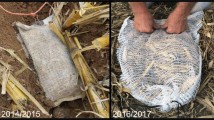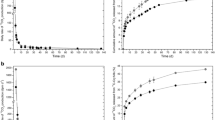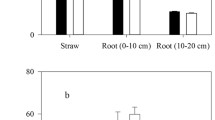Abstract
Purpose
The cultivation of genetically modified (GM) crops has raised environmental concerns, since large amounts of plant materials remain in the field after harvesting. Specific proteins of GM crops might negatively impact soil ecosystem by changing residue decomposition dynamics. Particularly, the residue decomposition of crop-wild hybrids, which were formed through transgene escape to wild population, remains unexplored.
Materials and methods
We used litter bags to assess residue (leaves, stems and roots) decomposition dynamics of two stacked genes from Bacillus thuringiensis (Bt) Cry1Ac and the sck (a modified CpTI gene encoding a cowpea trypsin-inhibitor) (Bt/CpTI) rice lines (Kefeng-6 and Kefeng-8), a non-transgenic rice near isoline (Minghui86), wild rice (Oryza rufipogon) and Bt wild rice at three sites. The enzyme-linked immunosorbent assay (ELISA) was used to monitor the changes of the Cry1Ac protein in Bt rice residues.
Results and discussion
Mass remaining, total N and total C concentrations of rice residues declined over time and varied among plant tissues, with significant differences among cultivar, crop-wild hybrids and wild rice, but no differences between Bt and non-Bt rice cultivars. The initial concentration of Cry1Ac was higher in leaves and stems than in roots and was different between rice types. The degradation dynamics of Cry1Ac fitted best to a first-order kinetics model and correlated with the level of total nitrogen in residues but did not correlate with the mass decomposition rate. The predicted DT50 (50 % degradation time) of the protein ranged from 10.7 to 63.6 days, depending on plant types, parts and burial sites. By the end of the study (~170 days), the protein was present in low concentration in the remaining residues.
Conclusions
Our results suggest that the impacts of the stacked Bt/CpTI gene inserts on the decomposition dynamics of rice residues are insignificant.






Similar content being viewed by others
References
Baumgarte S, Tebbe CC (2005) Field studies on the environmental fate of the Cry1Ab Bt-toxin produced by transgenic maize (MON810) and its effect on bacterial communities in the maize rhizosphere. Mol Ecol 14:2539–2551
Cortet J, Andersen MN, Caul S, Griffiths B, Joffre R, Lacroix B, Sausse C, Thompson J, Krogh PH (2006) Decomposition processes under Bt (Bacillus thuringiensis) maize: results of a multi-site experiment. Soil Biol Biochem 38:195–199
Daudu CK, Muchaonyerwa P, Mnkeni PNS (2009) Litterbag decomposition of genetically modified maize residues and their constituent Bacillus thuringiensis protein (Cry1Ab) under field conditions in the central region of the Eastern Cape, South Africa. Agric Ecosyst Environ 134:153–158
Dong S, Xiao M, Rong J, Liao H, Lu BR, Chen J, Song Z (2011) No effect of transgene and strong wild parent effects on seed dormancy in crop–wild hybrids of rice: implications for transgene persistence in wild populations. Ann Appl Biol 159:348–357
Escher N, Kach B, Nentwig W (2000) Decomposition of transgenic Bacillus thuringiensis maize by microorganisms and woodlice Porcellio scaber (Crustacea: Isopoda). Basic Appl Ecol 1:161–169
Flores S, Saxena D, Stotzky G (2005) Transgenic Bt plants decompose less in soil than non-Bt plants. Soil Biol Biochem 37:1073–1082
Heal O, Anderson J, Swift M (1997) Plant litter quality and decomposition: an historical overview. In: Cadisch G, Giller KE (eds) Driven by nature: plant litter quality and decomposition. CAB International Wallingford, Oxford, pp 3–30
Herman RA, Wolt JD, Halliday WR (2002) Rapid degradation of the Cry1F insecticidal crystal protein in soil. J Agric Food Chem 50:7076–7078
Hönemann L, Zurbrügg C, Nentwig W (2008) Effects of Bt-corn decomposition on the composition of the soil meso- and macrofauna. Appl Soil Ecol 40:203–209
Hopkins D, Gregorich E (2003) Detection and decay of the Bt endotoxin in soil from a field trial with genetically modified maize. Eur J Soil Sci 54:793–800
Icoz I, Stotzky G (2008) Fate and effects of insect-resistant Bt crops in soil ecosystems. Soil Biol Biochem 40:559–586
James C (2012) Global status of commercialized biotech/GM crops: 2011. International Service for the Acquisition of Agri-Biotech Applications, Ithaca, NY. ISAAA Brief No. 43
Kamota A, Muchaonyerwa P, Mnkeni PNS (2014) Decomposition of surface-applied and soil-incorporated Bt maize leaf litter and Cry1Ab protein during winter fallow in South Africa. Pedosphere 24:251–257
Kirk P (1950) Kjeldahl method for total nitrogen. Anal Chem 22:354–358
Lachnicht SL, Hendrix PF, Potter RL, Coleman DC, Crossley DA (2004) Winter decomposition of transgenic cotton residue in conventional-till and no-till systems. Appl Soil Ecol 27:135–142
Lehman RM, Osborne SL, Rosentrater KA (2008) No differences in decomposition rates observed between Bacillus thuringiensis and non-Bacillus thuringiensis corn residue incubated in the field. Agron J 100:163–168
Li YH, Wu KM, Zhang YJ, Yuan GH (2007) Degradation of Cry1Ac protein within transgenic Bacillus thuringiensis rice tissues under field and laboratory conditions. Environ Entomol 36:1275–1282
Liao CH, Luo YQ, Fang CH, Chen JK, Li B (2008) Litter pool sizes, decomposition, and nitrogen dynamics in Spartina alterniflora- invaded and native coastal marshlands of the Yangtze Estuary. Oecologia 156:589–600
Lu BR, Yang C (2009) Gene flow from genetically modified rice to its wild relatives: assessing potential ecological consequences. Biotech Adv 27:1083–1091
Lu H, Wu W, Chen Y, Zhang X, Devare M, Thies J (2010) Decomposition of Bt transgenic rice residues and response of soil microbial community in rapeseed-rice cropping system. Plant Soil 336:279–290
Moorhead DL, Sinsabaugh RL, Linkins AE, Reynolds JF (1996) Decomposition processes: modelling approaches and applications. Sci Total Environ 183:137–149
Oka HI (1988) Origin of cultivated rice. Japan Scientific Societies Press, Tokyo
Olson J (1963) Energy storage and the balance of producers and decomposers in ecological systems. Ecology 44:322–331
Palm CJ, Schaller DL, Donegan KK, Seidler RJ (1996) Persistence in soil of transgenic plant produced Bacillus thuringiensis var. kurstaki delta-endotoxin. Can J Math 42:1258–1262
Prihoda KR, Coats JR (2008) Fate of Bacillus thuringiensis (Bt) Cry3Bb1 protein in a soil microcosm. Chemosphere 73:1102–1107
Ream J, Sims S, Leach J (1994) Aerobic soil degradation of Bacillus thuringiensis var. kurstaki HD-73 protein bioactivity. Monsanto Company Laboratory Project MSL 13267
Saxena D, Stotzky G (2001) Bt corn has a higher lignin content than non-Bt corn. Amer J Bot 88:1704–1706
Sims SR, Holden LR (1996) Insect bioassay for determining soil degradation of Bacillus thuringiensis subsp. kurstaki CryIA(b) protein in corn tissue. Environ Entomol 25:659–664
Song ZP, Lu BR, Zhu YG, Chen JK (2003) Gene flow from cultivated rice to the wild species Oryza rufipogon under experimental field conditions. New Phytol 157:657–665
Song ZP, Zhu WY, Rong J, Xu X, Chen JK, Lu BR (2006) Evidences of introgression from cultivated rice to Oryza rufipogon (Poaceae) populations based on SSR fingerprinting: implications for wild rice differentiation and conservation. Evol Ecol 20:501–522
Tarkalson DD, Kachman SD, Knops JMN, Thies JE, Wortmann CS (2008) Decomposition of Bt and non-Bt corn hybrid residues in the field. Nutr Cycling Agroecosyst 80:211–222
Tharayil N, Suseela V, Triebwasser DJ, Preston CM, Gerard PD, Dukes JS (2011) Changes in the structural composition and reactivity of Acer rubrum leaf litter tannins exposed to warming and altered precipitation: climatic stress-induced tannins are more reactive. New Phytol 191:132–145
Vadiveloo J (1995) Factors contributing to varietal differences in the nutritive value of rice straw. Anim Feed Sci Technol 54:45–53
Venneria E, Fanasca S, Monastra G, Finotti E, Ambra R, Azzini E, Durazzo A, Foddai MS, Maiani G (2008) Assessment of the nutritional values of genetically modified wheat, corn, and tomato crops. J Agric Food Chem 56:9206–9214
Wang F, Yuan Q, Shi L, Qian Q, Liu W, Kuang B, Zeng D, Liao Y, Cao B, Jia S (2006a) A large-scale field study of transgene flow from cultivated rice (Oryza sativa) to common wild rice (O. rufipogon) and barnyard grass (Echinochloa crusgalli). Plant Biotechnol J 4:667–676
Wang HF, Wu YM, Liu JX, Qian Q (2006b) Morphological fractions, chemical compositions and in vitro gas production of rice straw from wild and brittle culm1 variety harvested at different growth stages. Anim Feed Sci Tech 129:159–171
Wang HY, Ye QF, Wang W, Wu LC, Wu WX (2006c) Cry1Ab protein from Bt transgenic rice does not residue in rhizosphere soil. Environ Pollut 143:449–455
Wang HY, Ye QF, Wu LC, Gan J (2007) Biodegradation of Cry1Ab protein from Bt transgenic rice in aerobic and flooded paddy soils. J Agric Food Chem 55:1900–1904
Wang WX, Zhu TH, Lai FX, Fu Q (2012) Event-specific qualitative and quantitative detection of transgenic rice Kefeng-8 by characterization of the transgene flanking sequence. Eur Food Res Technol 234:477–484
Wu W, Lu H, Liu W, Devare M, Thies JE, Chen Y (2009) Decomposition of Bacillus thuringiensis (Bt) transgenic rice residues (straw and roots) in paddy fields. J Soils Sediments 9:457–467
Xue K, Serohijos RC, Devare M, Thies JE (2011) Decomposition rates and residue-colonizing microbial communities of Bacillus thuringiensis insecticidal protein Cry3Bb-expressing (Bt) and non-Bt corn hybrids in the field. Appl Environ Microbiol 77:839–846
Xie JK, Kong XL, Chen J, Hu BL, Wen P, Zhuang JY, Bao JS (2011) Mapping of quantitative trait loci for fiber and lignin contents from an interspecific cross Oryza sativa × Oryza rufipogon. J Zhejiang Univ Sci B 12:518–26
Zurbrügg C, Hönemann L, Meissle M, Romeis J, Nentwig W (2010) Decomposition dynamics and structural plant components of genetically modified Bt maize leaves do not differ from leaves of conventional hybrids. Transgen Res 19:257–267
Zwahlen C, Hilbeck A, Gugerli P, Nentwig W (2003) Degradation of the Cry1Ab protein within transgenic Bacillus thuringiensis corn tissue in the field. Mol Ecol 12:765–775
Zwahlen C, Hilbeck A, Nentwig W (2007) Field decomposition of transgenic Bt maize residue and the impact on non-target soil invertebrates. Plant Soil 300:245–257
Acknowledgments
We thank the three anonymous reviewers for their valuable comments. We are also grateful to Dr. Yao Zhao and Yongqing Zhu, Prof. Xuhui Zhou of Fudan University for their suggestions in improvement of the manuscript. This study was supported by the Key Project for Breeding Genetically Modified Organisms (2009ZX08011-012B) and the National Natural Science Foundation of China (31170505).
Author information
Authors and Affiliations
Corresponding author
Additional information
Responsible editor: Scott X. Chang
Rights and permissions
About this article
Cite this article
Xiao, M., Fang, C., Dong, S. et al. Litterbag decomposition of residues from Bacillus thuringiensis (Bt) rice hybrids and the parental lines under multiple field conditions. J Soils Sediments 14, 1669–1682 (2014). https://doi.org/10.1007/s11368-014-0933-1
Received:
Accepted:
Published:
Issue Date:
DOI: https://doi.org/10.1007/s11368-014-0933-1




